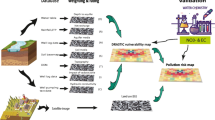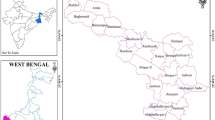Abstract
The aim of this study is to elaborate a synthetic document for the assessment of groundwater vulnerability to pollution in the Hajeb-Jelma aquifer. The specific object is to incorporate the Geographical Information System (GIS) to generate groundwater vulnerability and risk maps with DRASTIC model. Indeed, GIS could help to make the results of a complicated model more clear through visual representation, providing an applicable tool for decision makers. The vulnerability map of Hajeb-Jelma watershed shows three classes: moderate, high and very high depending on the intrinsic properties. The risk map shows a very high risk dependant on hydrogeological characteristics, land use and human impacts in major part of the Hajeb-Jelma region. These maps could serve as a scientific basis for sustainable land use planning and groundwater management in the Hajeb-Jelma region.






Similar content being viewed by others
References
Adamat R, Foster I, Baban S (2003) Groundwater vulnerability and risk mapping for the Basaltic aquifer of the Azraq basin of Jordan using GIS, remote sensing and DRASTIC. J Appl Geography 23:303–324
Aller L, Bennet T, Lehr JH, Petty RJ, Hackett G DRASTIC (1987) A standardised system for evaluating groundwater pollution potential using hydrogeologic settings. US Environment Protection Agency Report (EPA/600/2-87/035), Robert S; Kerr Environmental Research Laboratory, pp 455
Andreo B, Goldscheider N, Vadillo I, Maria Vias J, Neukum C, Sinreich M, Jiménez P, Brechenmacher J, Carrasco F, Hotzl H, Jesus Perles M, Zwahlen F (2005) Karst groundwater protection: first application of a Pan-European Approach to vulnerability, hazard and risk mapping in the Sierra de Libar (Southern Spain). J Sci Total Env 357:54–73
District of the Water Resources (DWR) of Sidi Bouzid (2004) Annuaires de surveillance de piézométrie et de salinité
District of the Water Resources (DWR) of Sidi Bouzid (2005) Comptes rendus des forages et piézomètres de surveillance
El Ghali A (1992) Evolution tectono-sédimentaire du bassin de Jebel Trozza au cours du Crétacé moyen et supérieur. Notes du service géologique de Tunisie, pp 59–75
Ferreira JP, Oliveira M (1997) DRASTIC groundwater vulnerability mapping of Portugal. Groundwater: an endangered resource. In: Proceedings of theme C of the 27th Congress of the International Association for Hydraulic Research, San Francisco, pp 6
Institut de la Météorologie Nationale (INM) (1974–2005) Tableaux climatologiques mensuels, stations Sidi Bouzid et Kairouan
Koschel R (1980) Etude hydrogéologique de la nappe de Hajeb el Ayoun-Jelma-Ouled Asker. Division des ressources en eau de Tunis, pp 117
Lobo Ferreira JP, Cabral, M (1991) Proposal for an operational definition of vulnerability for the European Community’s Atlas of groundwater resources, in the framework of the meeting of the “European Institute for water, Groundwater Work Group Brussels”
Margat J (1968) Vulnérabilité des nappes d’eau souterraine à la pollution (groundwater vulnerability to contamination). Bases de la cartographie, (Doc) BRGM, 68SGL198 HYD, Orleans France
Michaud Y, Lefebvre R, Martel R (2003) Vulnérabilité: Introduction et méthodologie. Centre Géoscientifique de Québec, pp 9
Moon SK, Woo NC, Lee KS (2004) Statistical analysis of hydrographs and water-table fluctuation to estimate groundwater recharge. J Hydrol 292:198–209
RAAD (2005) Annuaire d’exploitation des nappes phréatiques du gouvernorat de Sidi Bouzid. Rapport inédit
RAAD of Sidi Bouzid (2004) Carte agricole de Sidi Bouzid. Rapport inédit
Ramos-Leal JA, Rodriguez-Castillo R (2003) Aquifer vulnerability mapping in the Turbio river valley, Mexico: a validation study: Geofisica Internacional 42(1), pp141-156
Saidi S (2006) Etude de la vulnérabilité des ressources hydriques du bassin Hajeb-Jelma (Tunisie Centrale). Mémoire de Mastère de l’Université de Sfax, pp 121
Secunda S, Collin M, Melloul AJ (1998) Groundwater vulnerability assessment using a composite model combining DRASTIC with extensive land use in Israel’s Sharon region. J Environ Manage 54:39–57
SONEDE (2005) Exploitation des forages destinés pour l’alimentation en eau potable de la nappe Hajeb-Jelma. Rapport inédit
Sophocleous MA (1991) Combining the soil water balance and waterlevel fluctuation methods to estimate natural groundwater recharge: practical aspects. J Hydrol 124:229–241
Vrba J, Zaporozec A (1994) Guidebook on mapping groundwater vulnerability. International Association of Hydrogeologists, vol 16. International Contributions to Hydrogeology, Heise Hannover, pp131
Zaporozec A (2002) Groundwater contamination inventory, UNESCO Technical Documents in Hydrogeology. Contributions to IHP-V, Project 3.1
Zouari K (1998) Etude isotopique et hydrochimique des systèmes multicouches de Gafsa et de Hajeb el Ayoun-Jelma. Rapport final de coopération scientifique et technique. Projet AIEA. Code: TUN/8/012, pp 70
Author information
Authors and Affiliations
Corresponding author
Electronic supplementary material
Below is the link to the electronic supplementary material.
Rights and permissions
About this article
Cite this article
Saidi, S., Bouri, S. & Ben Dhia, H. Groundwater vulnerability and risk mapping of the Hajeb-jelma aquifer (Central Tunisia) using a GIS-based DRASTIC model. Environ Earth Sci 59, 1579–1588 (2010). https://doi.org/10.1007/s12665-009-0143-0
Received:
Accepted:
Published:
Issue Date:
DOI: https://doi.org/10.1007/s12665-009-0143-0




